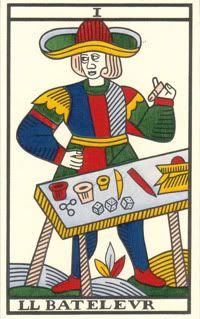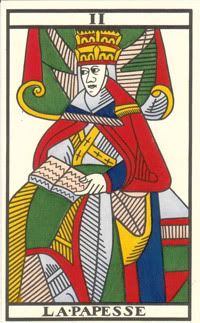Everything is waiting for us to see it.
Anything may be read.
I'm speaking of seeing and reading in the sense of divination--not as a method of fortune-telling, nor of predicting the future, but of opening oneself to messages looking for a destination. Everyone has the potential to be a receiver of messages, and most have experienced spontaneous divination; anyone who has been profoundly moved by a work of art in a way they can't explain, felt that the lyrics of a random song on the radio were speaking to them in the moment, found a passage in a book that provides an answer to an unspoken question. Often these messages are wordless revelations--a door cracks open, and we can walk through it under our own power. Disparate pieces of a puzzle suddenly lock together. Maybe it's a divine proto-language we've tapped into, or the sudden flap of a wing, a vision descending.
We may also employ any number of tools to invite this way of seeing. Sortilege, or the casting of lots, may be the oldest form of divination; stones, bones or wax in a bowl of water, anything can be thrown down and a reading found in the spaces. The practitioners of this method took Mercury as their patron in antiquity, and the element of mercury seems to be a wholly appropriate metaphor for the act itself--its form and the meaning found there relevant only to the moment, ever-changing, impossible to pin down.
All of us have a natural affinity for images--they are the most direct form of communication, understandable at a glance, a shortcut around the gridlock our minds might encounter when we try to express ourselves with words. Images can also allow us to communicate more directly with ourselves as well. I read tarot, or rather I look at tarot and try to see what it wants to say to me, and listen to how it speaks. I use the Noblet Marseille, a restoration of a Parisian deck printed in 1650, and this is unimportant aside from the fact that the Marseille deck is free of any esoteric overlays; the history and iconography of the Marseille and its variants is a fascinating and hotly debated subject, but if we pull it out from under the weight of its history it may be read as pure imagery, and becomes a hotline to insights--literally a way of seeing into ourselves and the situation at hand.
The method I use with the Noblet is the creation of Enrique Enriquez, and he calls it Eye Rhyme. I won't explain it here, it should be read in his own words, understood using his examples. I believe it was this way of seeing, not just the cards but an entire life and its content, that Allen Ginsberg was speaking of in his famous aphorism, "first thought, best thought". This understanding of the visionary state is one aspect of what drove Rimbaud to write the second of his "Voyant" letters, where he says, "This much is clear: I'm around for the hatching of my thought: I watch it, I listen to it: I release a stroke from the bow: the symphony makes its rumblings in the depths, or leaps fully formed onto the stage.". And later, in the same letter, "This language will be of the soul, for the soul, encompassing everything, scents, sounds, colors, thought latching onto thought and pulling.". The language he speaks of may be read by looking at the Marseille, where visions indeed act out our personal dramas again and again.
I can toss a few cards onto the floor and, like stones in a riverbed, follow their various paths to any number of ends. I can see how the figures on the trumps and courts regard each other, I can listen in on their conversations. The point in all of this is, simply, to look.
Look at the Bateleur, the first Trump:

As I write this he appears to me in the guise of legerdemain, and also as the seer I'm speaking of--he looks over his shoulder to the left, the past, perhaps engaged in memory and what can be found there, manipulating the mysterious objects on his table; is he casting lots, is he a practitioner of sortilege? The name he conjures for me, "legerdemain", and the word "sortilege" itself share the same root--leger, meaning light, or quick. Mercurial.
Look at the second trump, the Papesse:

She sits quietly, an open book in her lap. Has she found an answer she didn't know to ask there? She also looks to the left, but her manner suggests something altogether different from the gaze of the Bateleur, something other--is she a visionary as well? Is this the moment of visitation?
The point is to see. Anais Nin said, "We don't see things as they are, we see things as we are.". The tools are there for us to use, the tools are everywhere at hand.
Anything may be read.
I'm speaking of seeing and reading in the sense of divination--not as a method of fortune-telling, nor of predicting the future, but of opening oneself to messages looking for a destination. Everyone has the potential to be a receiver of messages, and most have experienced spontaneous divination; anyone who has been profoundly moved by a work of art in a way they can't explain, felt that the lyrics of a random song on the radio were speaking to them in the moment, found a passage in a book that provides an answer to an unspoken question. Often these messages are wordless revelations--a door cracks open, and we can walk through it under our own power. Disparate pieces of a puzzle suddenly lock together. Maybe it's a divine proto-language we've tapped into, or the sudden flap of a wing, a vision descending.
We may also employ any number of tools to invite this way of seeing. Sortilege, or the casting of lots, may be the oldest form of divination; stones, bones or wax in a bowl of water, anything can be thrown down and a reading found in the spaces. The practitioners of this method took Mercury as their patron in antiquity, and the element of mercury seems to be a wholly appropriate metaphor for the act itself--its form and the meaning found there relevant only to the moment, ever-changing, impossible to pin down.
All of us have a natural affinity for images--they are the most direct form of communication, understandable at a glance, a shortcut around the gridlock our minds might encounter when we try to express ourselves with words. Images can also allow us to communicate more directly with ourselves as well. I read tarot, or rather I look at tarot and try to see what it wants to say to me, and listen to how it speaks. I use the Noblet Marseille, a restoration of a Parisian deck printed in 1650, and this is unimportant aside from the fact that the Marseille deck is free of any esoteric overlays; the history and iconography of the Marseille and its variants is a fascinating and hotly debated subject, but if we pull it out from under the weight of its history it may be read as pure imagery, and becomes a hotline to insights--literally a way of seeing into ourselves and the situation at hand.
The method I use with the Noblet is the creation of Enrique Enriquez, and he calls it Eye Rhyme. I won't explain it here, it should be read in his own words, understood using his examples. I believe it was this way of seeing, not just the cards but an entire life and its content, that Allen Ginsberg was speaking of in his famous aphorism, "first thought, best thought". This understanding of the visionary state is one aspect of what drove Rimbaud to write the second of his "Voyant" letters, where he says, "This much is clear: I'm around for the hatching of my thought: I watch it, I listen to it: I release a stroke from the bow: the symphony makes its rumblings in the depths, or leaps fully formed onto the stage.". And later, in the same letter, "This language will be of the soul, for the soul, encompassing everything, scents, sounds, colors, thought latching onto thought and pulling.". The language he speaks of may be read by looking at the Marseille, where visions indeed act out our personal dramas again and again.
I can toss a few cards onto the floor and, like stones in a riverbed, follow their various paths to any number of ends. I can see how the figures on the trumps and courts regard each other, I can listen in on their conversations. The point in all of this is, simply, to look.
Look at the Bateleur, the first Trump:

As I write this he appears to me in the guise of legerdemain, and also as the seer I'm speaking of--he looks over his shoulder to the left, the past, perhaps engaged in memory and what can be found there, manipulating the mysterious objects on his table; is he casting lots, is he a practitioner of sortilege? The name he conjures for me, "legerdemain", and the word "sortilege" itself share the same root--leger, meaning light, or quick. Mercurial.
Look at the second trump, the Papesse:

She sits quietly, an open book in her lap. Has she found an answer she didn't know to ask there? She also looks to the left, but her manner suggests something altogether different from the gaze of the Bateleur, something other--is she a visionary as well? Is this the moment of visitation?
The point is to see. Anais Nin said, "We don't see things as they are, we see things as we are.". The tools are there for us to use, the tools are everywhere at hand.




No comments:
Post a Comment